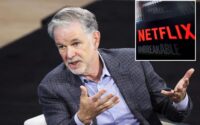Nate Silver blasts COVID lockdowns that closed churches
Nate Silver blasted COVID-era closures of churches while other public spaces, such as museums, were permitted to operate with fewer restrictions.
“It’s kind of crazy (and tells you a lot about who was writing the restrictions) that churches in some jurisdictions were subject to more restrictions than museums!” Silver, the data journalist and founder of the FiveThirtyEight statistical analysis news site, tweeted.
“Not even attempting to follow any sort of epidemiological principles.”
Silver was reacting on Tuesday to a blog post by journalist David Zweig, who wrote that a church and its members in Santa Clara County, Calif. were “the targets of an unprecedented surveillance operation” after they “defied” COVID restrictions.
In May 2020, the Calvary Chapel in San Jose and its pastor, Mike McClure, “brazenly defied” a shelter-in-place order imposed by public health officials in the county, Zweig wrote.

Sara Cody, the head of the county public health department, announced in the fall of 2020 that churches were allowed “the lesser of 100 people or twenty-five percent capacity” while museums “could run at fifty percent,” according to Zweig.
Stores “had no capacity limits placed on them at all” in Santa Clara County, according to Zweig.
McClure’s church “began holding indoor gatherings, often with hundreds of worshippers, a large portion of whom were without masks, in breach of distancing rules, and singing,” Zweig wrote.

The church filed suit against the county alleging that its health department “went to extraordinary, and potentially unlawful, lengths to enforce its decrees” — including “levying more than $2 million in fines” as well as instituting a “multi-faceted surveillance program of the church and its members, breathtaking in scope and reminiscent of totalitarian regimes, rather than an American county health department,” Zweig wrote.
The surveillance methods included “stakeouts, forced in-person monitoring of prayer groups and other intimate activities, and tracking the cellular mobility data of churchgoers,” according to Zweig.
“Much of Santa Clara’s restrictions early on were tied to state requirements, which were harsher on churches than stores,” Zweig wrote.
“But Santa Clara expanded the chasm between houses of worship and retail establishments beyond what the state prescribed,” according to Zweig.
Zweig sought answers from local authorities in the Bay Area as to “why malls had looser conditions than churches” but he was “not given an explanation.”
The Post has sought comment from Santa Clara County and Calvary Chapel.
In response to Silver’s tweet, Zweig noted that “the ban on gathering in houses of worship lasted for seven months.”

“Many of these people were suffering from addiction issues, isolation, depression, and rely on the church for support,” according to Zweig.
“These are also public health concerns.”
Silver replied that “most of the evidence suggests that extended lockdowns and closures were bad from a utilitarian/consequentialist standpoint,” though he added the caveat that it was “hard to prove.”
“But they were also bad from a civil liberties standpoint, especially when we’re talking about religious worship,” Silver tweeted.
Silver rose to national prominence in 2008 when he accurately predicted the results of the presidential and Congressional elections while heading the FiveThirtyEight election forecast unit of The New York Times.

In 2013, Silver and his site migrated from the Times to Disney-owned ESPN. In 2018, FiveThirtyEight was acquired by ESPN’s corporate sister, ABC News.
Silver has emerged in recent months as a critic of public health officials’ handling of the COVID pandemic.
In August, he tweeted that “liberal public health elites” pressured Pfizer to delay fast-track approval of its COVID-19 vaccine until after the 2020 presidential election — thus denying then-President Donald Trump a political win before voters headed to the polls.
“‘Trump pushed for vaccine approvals too fast’ is the worst possible critique of the Trump administration’s COVID policy,” Silver tweeted last summer.
“That probably saved a lot of lives. If anything approval should have been faster.”
In a subsequent tweet, Silver wrote that “liberal public health elites” pushed Pfizer to “change its original protocols” that govern its authorization of vaccines so that the decision would be put off until after Election Day two years ago.


